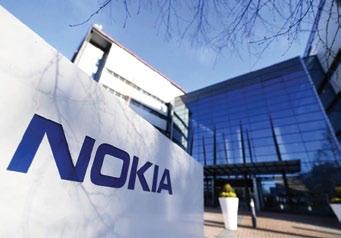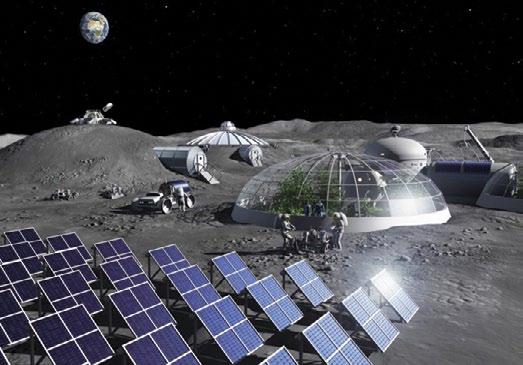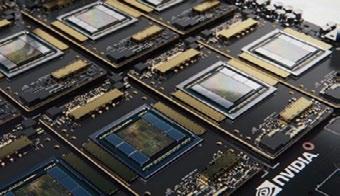
7 minute read
Winning business New contracts and orders in industry
NeWS
New contracts and orders in industry
Nokia Selected To provide finland With 5g raN
Nokia has been selected by fellow Finnish phone company Elisa to provide nationwide 5G radio access networks (RAN) with the aim of providing ultra-fast, low latency broadband mobile service to customers.
The deal continues the two company’s partnership into the 5G era as Elisa attempts to digitalise Finland and make it a world leader in the 5G market.
Deployment of the project using Elisa’s AirScale 5G radio network portfolio is due to begin immediately.
According to Nokia, their 5G RAN supports a “flexible, AI-integrated architecture,” which the phone titans claim “triples the throughput of [their] market-leading RAN technology” emphasising performance and scalability to bring 5G networks to as many people as possible.
Nokia has also recently been selected to take over 5G services in Britain by British Telecommunications (BT) as they cease operations with Chinese phone company Huawei.
The project will also focus on mobile network technology migration so that new radios will server both 4G and 5G subscribers across the country. Elisa is expected to discontinue service for their 3G network starting in 2023 to support its focus on 5G.
Elisa is the first operator of its kind in Finland to install a commercial liquid cooling 5G base station, which they claim reduces the potential energy expense of that base by 30% and CO2 emissions by as much as 80%. Nokia has delivered zeroemission products to over 150 company’s worldwide and is committed to decreasing emissions from its operations by as much as 41% by 2030.
Veli-Matti Mattila, CEO of Elisa, said: “We continue facilitating the benefits of 5G to our customers in Finland, one of the world’s leading mobile service markets and are delighted to work with Nokia to enhance our capabilities.
“Nokia has been an important strategic partner for us a long time and its technology has helped us to deliver state-of-the-art 5G-based enhanced mobile broadband experiences to our customers.
Pekka Lundmark, President and CEO of Nokia said: “Nokia has a long-standing partnership with Elisa, which we are excited to extend into the 5G era as their strategic supply partner. Together we have delivered many technology ‘firsts,’ including installing the first-ever commercial liquid cooling station, which highlights our shared commitment to decreasing emissions while providing worldclass connectivity.
Visit: www.elisa.com For more information: www.nokia.com
Dawn Aerospace Awarded ESA 3D Printed Rocket Engine Contract
The European Space Agency (ESA) has awarded a contract worth €385,000 to Dutch launch provider Dawn Aerospace as part of its Future Launcher Preparatory Programme (FLPP).
Through the contract, ESA will provide support to Dawn for the development of 3D printed combustion chambers for high performance, high combustion pressure rocket engines.
“We are proud to work in cooperation with the European Space Agency,” said Jeroen Wink, Dawn Aerospace CEO.
The materials commonly used in additive manufacturing, such as stainless steel, titanium and Inconel lack the necessary thermal conductivity needed for ultra-high-performance combustion chambers. The work that Dawn is planning for the project involves 3D printing high melting temperature and high thermally conductive materials.
The finished products will then be utilised for the Mk-II Aurora spaceplane.
As a technology, Additive Manufacturing offers lighter and cheaper rocket engines with fewer individual parts and ultimately higher performance.
ESA’s FLPP is a key component of Europe’s space access strategy and the programme is overseeing research into a variety of new launch technologies, lightweight and high-performance systems, low-cost structures, reusability and green launch systems. Learn more at: www.esa.int/Enabling_Support/Space_Transportation/ New_Technologies/FLPP_preparing_for_Europe_s_next-generation_ launcher

An artist’s impression of the Dawn mk-II Aurora
WINNINGbuSINESS
Metalysis Awarded ESA Funding To Find Oxygen In Moon Rock
The UK’s Metalysis has been awarded a nine-month funding contract by the European Space Agency (ESA) for the development of technology that transforms moon dust and rock into oxygen and metal powders, paving the way for the eventual establishment of a lunar base.
The Sheffield-based company’s recent study, conducted in partnership with Glasgow University, found that the technology could extract 96% of the oxygen from a material called JSC-2A - a simulant material with a composition similar to regolith, or moon dust.
The process, which has been used at an industrial scale on Earth in titanium and tantalum production since 2018 but with oxygen as a byproduct, involves the passing of an electrical current through the material, resulting in the creation of pure oxygen with the metal powders being a useful byproduct.
Ian Mellor, Managing Director at Metalysis, said: “We are really pleased Metalysis is involved in this exciting programme; taking an established earth-based technology and applying it to a lunar setting. The fact that the process is capable of simultaneously producing both oxygen and metal powders is unique, offering potential solutions to two key areas of the ESA Space Resources Strategy.”
The creation of oxygen on the Moon would be of enormous benefit, not just for human life support, but also in the production of rocket fuel for further exploration. The metal powders could be utilised in the future for lunar construction workers to use as a building material.
If the process can be refined and made to work well enough, it will lead to the creation of extraction facilities that produce oxygen and valuable materials on the lunar surface, saving time and bringing down costs hugely as they will not need to be hauled from Earth.
Sue Horne, Head of Space Exploration at the UK Space Agency, said: “In the future, if we want to travel extensively in space and set up bases on the Moon and Mars, then we will need to make or find the things required to support life - food, water and breathable air.
According to ESA estimates, extraterrestrial resource harvesting could create potential revenues of €73-€170 billion between 2018 and 2045. This will be in large part dependent on the successful establishment of a permanent human presence on the Moon, for extraction of lunar minerals and to act as a staging post for missions into deeper space. Learn more at: www.metalysis.com

An artist’s impression of moon Base activities. Photo: eSA - P. Carril
Nvidia To Invest £40 Million Into UK’s Most Powerful Supercomputer
US computing chip company Nvidia has announced its intention to invest roughly £40 million into building the UK’s most powerful supercomputer, which the company claim is to be used in drug discovery and for healthcare challenges such as coronavirus.
Nvidia hopes to build the machine in Cambridge, England, appropriately named “Cambridge-1,” by the end of the year.
Among its first partnerships will be pharmaceutical manufacturers such as GlaxoSmithKline and AstraZeneca, gene analysis company Oxford Nanopore and researchers at Guy’s and St Thomas’ NHS Foundation Trust and King’s College London.
This news comes as Nvidia is still awaiting confirmation of their $40 billion (€33 billion) purchase of Arm Holdings last month, which is potentially the largest purchase in semiconductor history.
The supercomputer could help revolutionise clinical trials in the face of the pandemic owing to their ability to analyse millions of molecules before deciding which ones will prove the most useful, which could accelerate the typically slow and costly journey for drug discovery.
Jensen Huang, Nvidia’s co-founder and chief executive, said: “The Cambridge-1 supercomputer will serve as a hub of innovation for the UK, and further the groundbreaking work being done by the nation’s researchers in critical healthcare and drug discovery.”
Back in January, the first-ever drug molecule invented solely by AI was announced. The entire process took 12 months, which is a major step up fro the average four-and-a-half years the process would take manually, suggesting this could be a significant technological advancement for the sector.
In addition to Cambridge-1, Nvidia also unveiled a set of AI tools specifically designed to help with drug discovery dubbed “Nvidia Clara Discovery.” The chip manufacturers claim the programme could support researchers by analysing data on a massive scale, including information on existing treatments and research literature.
In a statement, Matt Hancock, UK health secretary, said: “Accelerating drug discovery has never been so important, and it is investments like this that can make a real difference in our fight against countless diseases.”
The company also announced the supercomputer would become part of a planned “AI Centre of Excellence” in Cambridge alongside another planned build which they hope will emerge from their partnership with Arm. Learn more at: www.nvidia.com/en-gb











